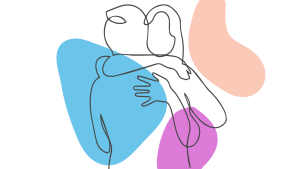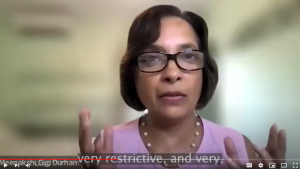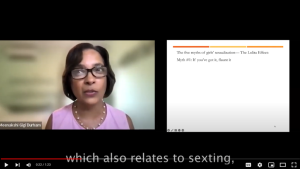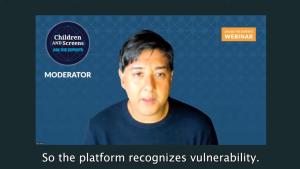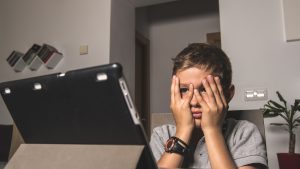
Pornography and sexually explicit material are everywhere these days, and children are encountering it online at younger and younger ages. According to published reports, 40-50% of 11- to 13-year-olds have reported having been exposed to pornography on the internet. Whether accessed intentionally or accidentally, pornography can have lasting effects on teens’ mental and sexual health as well as the intimate relationships they develop.
While it can be uncomfortable to have productive conversations with adolescents about pornography, it’s crucial that parents engage with their kids on this tricky topic, which is why Children and Screens has brought together an interdisciplinary panel of the world’s top researchers, clinicians, and parenting experts to present these twelve helpful tips.
Listen And Learn
When talking about porn with an adolescent, don’t lecture. Ask questions, listen, and find teachable moments where you can bring up the topic in a non-judgmental way. Encourage your kids to share their thoughts on porn and engage them in a dialogue by asking open-ended questions. – Gail Dines, PhD, President and CEO of Culture Reframed, Professor Emerita of Sociology and Women’s Studies, Wheelock College, Boston
Dangerous Conditions Ahead
Even if kids understand that porn sex isn’t “real,” serious problems can emerge if they learn to condition their sexual arousal to it. Rules for obtaining consent are wise, but if a young man can only get an erection while engaging in a porn fetish, then his perception of consent is likely to be extremely…flexible. Moreover, too many partners lack conviction in their right to say ‘no’ to activities that are common in porn. It takes a strong will and adult confidence to tell someone you like that you’re not interested in engaging in whatever practices they’ve conditioned themselves to need in order to climax. Even adult women have trouble with this challenge, and teens need coaching to help them refuse what they don’t want. – Gary Wilson, author of Your Brain on Porn: Internet Pornography and the Emerging Science of Addiction
Knowledge Is Power
Never jump into a conversation without educating yourself first. You’ll be less awkward and more helpful if you have some knowledge about porn, what kinds of content kids might find online, and what the key messages you want to communicate are. If there are other family members (aunt/uncle/grandparent) who have a better rapport with your teen, encourage them to initiate the conversation, as young people are more likely to take advice from someone they’re comfortable with. No matter what happens, stay calm. If you have an outsized reaction, your teen is less likely to talk to you again, and the way you respond in this moment will help shape countless conversations to come. – Jo Robertson, Research and Training Lead for The Light Project
Prepare For The Inevitable
Our research shows that children are as likely to find porn accidentally (through pop ups, social networking sites, etc.) as they are to actively search for it or be shown it by others. As a result, we argue that it’s important not just to limit access, but also to build resilience in children to the potentially harmful effects of porn for when they inevitably do encounter it. This can limit the potential damage on children’s relationships, behavior, and attitudes toward sex. – Elena Martellozzo, PhD
Join, Don’t Judge
Join in age-appropriate conversations with your kids about their bodies and puberty in a non-judgmental way. Meet your kids’ natural curiosity with honest, age-appropriate answers. Admit when you don’t know something and let them know you’ll find out for them. If they’re older, go online with them to reputable, age-appropriate sources so they know where they can find medically accurate information. Communicating openly with your kids builds trust and sets you up as the person your kids want to come to when they come across pornography or see something disturbing online. Need support answering your kids’ questions? Visit AMAZE.org/parents. – Lucinda Holt, Director of Communications for Answer, Publisher of Sex, Etc.
Adverse Effects May Include…
The availability, affordability, accessibility, and perceived anonymity of internet pornography has facilitated widespread consumption, including among children and adolescents. While people are still working to understand the full impacts, unwanted effects like erectile dysfunction in young males, objectification of and violence toward girls and women, and discord in intimate partner relationships can develop as a result. Protecting youth through appropriate monitoring of internet use and engaging in age-appropriate discussions about pornography is important to safeguard against both nuanced and direct harms related to underage access of internet pornography. – Dr. Marc Potenza, PhD MD
Be Direct And Redirect
If you discover your child has accessed porn, tell them they’re not in trouble, but that you want to discuss what they’ve seen. Porn and other sexually explicit materials are ubiquitous today, so this won’t be the last time they encounter it, and teaching your kids how to be educated consumers of any media they access will help them discern what’s reliable information and what isn’t. Additionally, explain why you don’t think it’s a good idea for them to watch porn and instead point them toward more age-appropriate resources developed by actual educators, like Amaze if they’re younger, or Sex, Etc. if they’re teens. To learn more, listen to this podcast about how to talk with your kids about porn and sexuality in general. – Elizabeth Schroeder, EdD, MSW, Sexuality Education Expert
Keep It Comfortable
If you find out that your child is watching porn (either in person or you see their web history), approach them calmly. Assure them that it’s perfectly normal and apologize for not talking to them about porn (or sex) if you haven’t yet. This will diffuse the awkwardness and defensiveness. Make plans for a more comfortable time to discuss what pornography is and how you would like them to think about it, etc. – Megan K. Maas, PhD
Keep It Real
Sexual curiosity is a normal part of adolescent development, and sex is a part of healthy adult relationships. As parents, it’s our job to be resources for our children as they grow into sexual beings. We hear from teens that they use pornography to learn about sex: what it is, how to do it, etc. Talk with your children – especially teens – about your views on sex and pornography. Help them understand what’s not real about porn (the size of sex organs, that real life is messy, etc.) and give them alternative sources of sex ed that are more accurate and realistic (e.g., Go Ask Alice! or Scarleteen). – Michele Ybarra, MPH PhD, President and Research Director of the Center for Innovative Public Health Research
Communication Is Key
The internet provides seemingly endless pornographic content which adolescents may access easily, and which may be confusing to them. Parents should communicate in an age-appropriate manner with their children about pornography and the potential negative impacts that it may have. Parents can also ask open and non-judgmental questions about their teen’s potential motivations for pornography use (for instance, are they accessing it to cope with negative moods or feelings of loneliness?). Parents should protect children and adolescents from being exposed to age-inappropriate material, considering both the quantity and content of pornography use. – Matthias Brand, PhD
Keep Calm And Parent On
If you discover your child has been exposed to pornography (whether intentionally or unintentionally), your conversation will be more effective if you stay calm, go slowly, and practice the 3 E’s of Effective Discipline. 1) Explore – Ask questions to understand where they viewed it, what they saw, and how they felt. 2) Explain – Describe your concerns with explicit content. Invite their perspective. 3) Empower – Invite them to develop solutions to making safe, healthy decisions in a way you can both feel good about. Remember to minimize controlling techniques, as these only push that unwanted behavior underground. – Dr. Justin Coulson, HappyFamilies.com.au
Hit The Books
Pornography today is totally different from pornography of the past in regards to its effects on children’s brains. For parents looking to learn about what their kids may encounter and how to handle it, we always recommend Your Brain on Porn: Internet Pornography and the Emerging Science of Addiction an easy to read book by former science teacher Gary Wilson. It offers hundreds of recovery stories and tips, along with advice on how to have those tricky conversations with your children. – Mary Sharpe, Advocate (lawyer), Chair of The Reward Foundation – Love, Sex & the Internet.
Though you may think your kids are too young to be dealing with many of the issues raised by the experts here, consider the People, Pornography and Age Verification survey which found that, while 75% of parents interviewed believed their children had not seen online porn, 53% of their kids reported that they had, in fact, encountered it. As these tips demonstrate, parents can help mitigate the dangers and educate their children at the same time by listening, learning, and having calm, judgment-free, and age appropriate conversations. It may be awkward in the moment, but it’s more than worth it in the long run.
